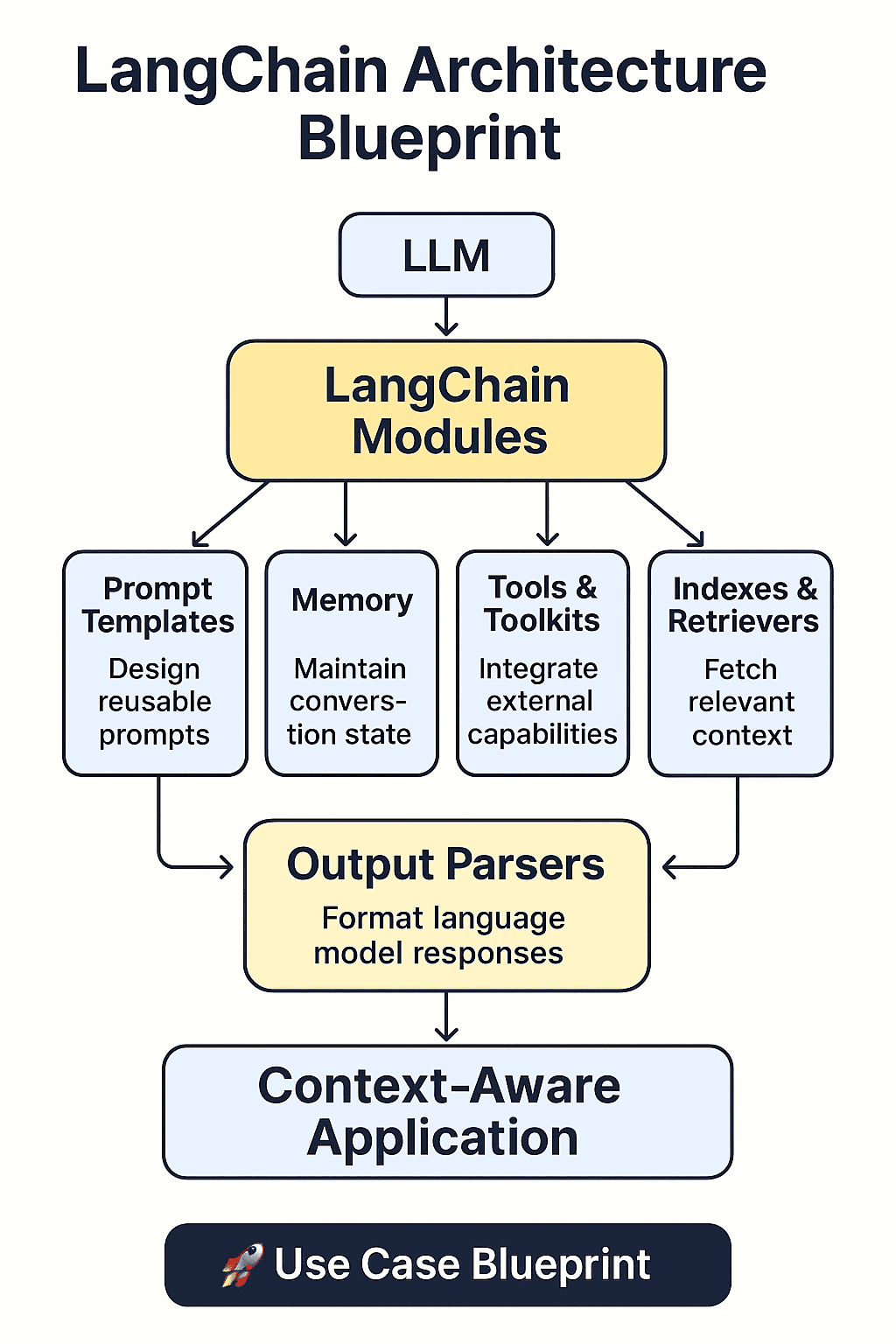LangChain in Practice: Tools, Templates & Memory Walkthrough
In the previous module, we explored the core concepts of LangChain — what chains, agents, tools, and memory are and why they matter. Now it’s time to connect those pieces and walk through how to use them together to build a context-aware, multi-functional LLM application.
This module focuses on practical integration:
- 🧠 Prompt templates + LLM + memory = intelligent chatbot
- 🔧 Tools + chains = agents with real-world capabilities
- 📦 Document loaders + vector stores = RAG-powered search
Below diagram depict Langchain component blueprint:

Each section below includes guidance, tips, and 🛠️ Try This blocks so you can build while you learn.
🧱 Prompt Templates
PromptTemplates let you design structured prompts with dynamic variables. Ideal for standardizing inputs to your LLMs.
🛠️ Try This: Create a prompt template that accepts a product_name and asks the LLM to generate a one-line elevator pitch.
PromptTemplate.from_template("Give me a one-line pitch for {product_name}")💡 Tip: Keep prompt templates modular and reusable across chains.
🧠 Memory
LangChain offers memory modules like ConversationBufferMemory, ConversationSummaryMemory, and EntityMemory.
🛠️ Try This: Use ConversationSummaryMemory for long chats to reduce token size while preserving context.
ConversationSummaryMemory(llm=ChatOpenAI()) ⚠️ Common Pitfall: Avoid unbounded memory in production—can lead to excessive cost or latency.
🔧 Tools & Toolkits
Tools extend your LLM’s capabilities. Combine them with Agents or use them in Chains.
🛠️ Try This: Load a calculator tool and let your agent solve “What is 5 * sqrt(49)?”
💡 Tip: Use LangChain’s built-in load_tools or define your own custom tools for APIs.
🔄 Chains
Chains help you sequence LLM calls and other logic. Common types include:
- LLMChain
- SequentialChain
- RouterChain
🛠️ Try This: Create a SequentialChain that extracts entities from text, then summarizes them.
⚠️ Gotcha: Ensure your intermediate chain outputs match the next chain’s expected inputs.
📄 Document Loaders & Vector Stores
Perfect for building document Q&A or semantic search bots.
🛠️ Try This: Load a PDF using PyPDFLoader, chunk it, embed using OpenAIEmbeddings, and store in FAISS.
💡 Tip: Use RecursiveCharacterTextSplitter for balanced token chunking.
🧾 Output Parsers
Output Parsers help you convert LLM text into structured data formats — useful for validation and interop.
🛠️ Try This: Use PydanticOutputParser to extract structured product info (name, price) from text.
⚠️ Best Practice: Always show format_instructions to the LLM as part of the prompt.
📚 Recap
This module focused on practical workflows using LangChain building blocks. Here’s what you’ve integrated:
- Templates + LLMs → Structured generation
- Memory + Chains → Conversational assistants
- Tools + Agents → Real-world automation
- Document loading + RAG → Knowledge bots
- Output Parsers → Structured API-like responses
In the next module, we’ll build complete apps using these integrated patterns.
➡️ Ready? Let’s Build a LangChain-Powered Assistant →
